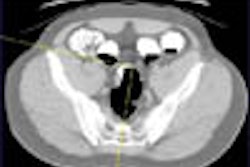The Symposium for Computer Applications in Radiology (SCAR) has become the premier meeting for PACS and digital image management. This year's meeting in Cleveland was the largest ever: Nearly 2,000 people attended this year's meeting, the first SCAR show to be held in a convention center instead of a hotel. The attendance level represented an 8% gain since last year's meeting in Salt Lake City.
Participants attended a full slate of scientific presentations, special sessions, and of course, the society's SCAR University didactic program. SCAR wasn't all about PACS, either. The Society for Computer Applications in Radiology has been aiming to broaden its meeting's appeal, featuring sessions on topics such as computer-aided detection, structured reporting, and an update on the National Institute for Biomedical Imaging and Bioengineering (NIBIB).
But PACS is still the meeting's primary draw. And as market acceptance of PACS increases, it's important to keep in mind some of the drawbacks of the technology. In his keynote address at SCAR, Cleveland Clinic department of radiology chair Dr. Michael Modic said that while PACS can bring major productivity benefits, it can also create problems for imaging departments.
The technology is expensive, and can drive productivity improvements for radiologists and radiologic technologists that can be challenging to sustain. In addition, equipment failures, in particular the RIS, can product catastrophic results across a healthcare system.
Training and quality assurance programs are crucial, Modic said. And frequent measuring can help establish benchmarks that help lift the quality and productivity of the entire enterprise.
Security and disaster recovery
In today's era of Health Insurance Portability and Accountability Act (HIPAA) regulations, it's no surprise that security would be on the minds of SCAR attendees. In fact, the best time to begin developing a PACS security strategy is before the equipment is installed, said security expert Samuel Dwyer, Ph.D. of the University of Virginia Health System in Charlottesville.
But it's not too late if you already have a PACS in place. In his SCAR presentation, Dwyer advocated a methodology that calls for policies, procedures, assessments, and training to be utilized in creating and maintaining security. Tools should be monitored and updated continuously, he said.
To create a security plan, the PACS administrator should first determine what needs to be protected. Also to be examined: the value of the assets; vulnerability to intrusion; potential methods of intrusion; potential perpetrators of attacks; and prevention plans to protect the PACS from hack attacks.
After assembling a list of assets, Dwyer suggested that the administrator should define the overall security objectives. First, the measures the institution already has in place to support these objectives should be examined. A risk assessment of the PACS vulnerabilities should be conducted, with risks quantified as to potential of occurrence, he said.
The PACS team should also develop a response plan. Dwyer recommended a combination of hardware and software tools such as firewalls, packet sniffers, and intrusion detection systems as part of an ongoing security policy.
Disaster recovery and security planning often go hand in hand. In another talk, Dr. Gary Wendt of the University of Wisconsin Hospitals and Clinics in Madison discussed a disaster recovery plan his institution had implemented.
To maintain the integrity of its archives, the UW PACS relies on a variety of media, both spinning and static, Wendt said. The institution utilizes a dual online archive on physically independent servers with full network backbone bandwidth to the primary and backup archive locations.
This approach confers a number of benefits, including the minimizing of damage caused by a physical disaster such as a fire or a flood. In addition, the two servers provide instantaneous failover capability in the event of a disaster. The dual-server architecture eases upgrades and maintenance to hardware and software by the IT department, Wendt said.
He emphasized that the most essential component of any disaster recovery plan is thorough training of all personnel, as well as extensive documentation, of each step to be taken in the event of a catastrophic PACS failure.
Web/image distribution
Innovative utilization of Web technology was also on display at the meeting. Researchers from the University of California, San Francisco, discussed their homegrown solution to aid radiologists in determining whether prior studies were available on a PACS or accessible only in film form.
The UCSF team wrote a Web-based Java applet that allows radiologists to query both the hospital's PACS and RIS networks to find out if legacy films are available. The database query tool was based on the logic that if a study is listed in the RIS database but did not have a record in the PACS, then it was probably a legacy film study. A Web-based user interface was accessible via an icon on the radiologist's desktop.
Clicking on the icon launches a Web browser, which passes on the patient's ID and accession numbers to a Java server pages (JSP) Web page. The page queries the PACS and RIS databases, and passes the results on to the radiologists.
Users can access the diagnostic report for the exam by clicking a button, which opens a separate JSP page that retrieves the report from the RIS. The UCSF team said the tool has helped radiologists work more efficiently, and remain within the same clinical context when reading a patient’s images.
In another presentation, radiologists at Maine Medical Center in Portland briefed attendees on a successful pilot program to encourage referring physicians to convert to Web-based image access. MMC provided temporary use of a Web-enabled PC and printer to referring physicians from non-MMC offices. In exchange, the office locations would provide space and support at their sites, as well as feedback on the system.
After installation, group presentations and dedicated training classes were given, with limited onsite assistance provided. Dr. Matthew Ralston reported that the program successfully promoted the adoption of the system by the referring physicians.
Sometimes it's necessary to provide digital image distribution to referring physician even before a PACS has been installed. That was the case at M. D. Anderson Cancer Center in Houston, where an application service provider-based image distribution service was set up to meet the needs of a new faculty office building across the street from the main center.
Rather than accelerate its ongoing PACS implementation plan, MDACC decided to proceed with an ASP-based service, said Dr. Kevin McEnery. MDACC reported that over 50% of images stored on the server were subsequently reviewed by the referring physicians, he said. The institution also reported high anecdotal evidence of clinician satisfaction.
Technologist matters
With the current shortage of RTs expected to worsen in coming years, PACS may become a critical tool for increasing productivity. To test this theory, SCAR's Research & Development Committee and consulting and data collection firm IMV Medical Information Division of Des Plaines, IL, surveyed 117 imaging facilities to measure productivity gains from PACS and information systems.
PACS did have an impact on the surveyed sites, but the effect wasn't always positive. In fact, institutions still in the first year of PACS implementation actually reported a decline in RT productivity, said Dr. Bruce Reiner of the Baltimore VA Medical Center.
This decline was attributed to the learning curve that accompanies PACS implementation. Responding sites with PACS in operation for more than a year reported productivity of 3,245 exams per technologist FTE, 13.9% higher than sites without PACS, and 27.8% higher than those in the early adopter-phase of PACS implementation. More research is planned.
Technologist productivity with CR and DR systems was the topic of two sessions during the meeting. Researchers evaluated whether DR's higher cost could be offset by the productivity gains that occur when RTs no longer need to hand-carry imaging cassettes to CR readers of film processors.
The results found no clear winner. While technologists using DR clearly had a productivity edge, CR made a good showing, and may still hold the price-performance edge in some situations.
In research presented by the Baltimore VA Medical Center, there were no statistically significant differences between the modalities for patient preparation time or exposure time. Among other findings, DR showed a major advantage in terms of reducing patient positioning and quality-control times. These time savings helped reduce the total time of DR studies compared with CR, said research assistant Steve Severance.
In another presentation, UCSF's Katherine Andriole, Ph.D. presented results evaluating CR, DR, and plain-film x-ray in an outpatient clinic. The UCSF team concluded that both CR and DR can offer major productivity advantages over analog x-ray for facilities with throughputs of 30 to 50 patients a day. In addition, both digital approaches can also sharply reduce the amount of time it takes to produce images, thus improving the overall efficiency of the department, she said.
With respect to CR versus DR, the group believes that CR performance is roughly equivalent to DR. As in the BVAMC study, DR probably enjoyed a competitive advantage because a dedicated chest DR system was being compared to a multipurpose CR unit, Andriole said.
Ultimately, the researchers concluded that the best indicator of whether to deploy DR or CR might be procedure volume. In low-volume settings, DR probably isn't cost-effective, Andriole said.
By Erik L. Ridley
AuntMinnie.com staff writer
June 6, 2002
Copyright © 2002 AuntMinnie.com



















